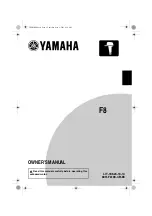
14
SP 75 T / SP 95 T / SP 125 T
2.0 - 2002
Segelboote und sehr schnelle Booten können gelegentlich durch
auf die rückseitige Fläche des Tunnels auftreffendes Wasser
gebremst werden (Fig. 1).
Dies kann dazu führen, daß sich der Thruster durch den perma-
nenten Wasserdurchfluß hörbar passiv zu drehen beginnt.
Das Problem kann je nach Möglichkeit auf zwei Arten beseitigt
werden.
1. Der störende Effekt wird am deutlichsten reduziert, indem man
im Rumpfbereich hinter dem Tunnel eine Aussparung vornimmt.
Dadurch werden Auftreffläche und störender Effekt eliminiert
(Fig. 2).
Tiefe und Form dieser Aussparung hängen vom Boot ab.
Die Innenseite des Tunnels sollte von vorne prinzipiell nicht
sichtbar sein.
Der mögliche Winkel der Aussparung hängt meist von der
Rumpfform ab. Bedingt durch die Wasserströmung in diesem
Bereich sollte dieser Winkel leicht nach unten gerichtet sein.
2. Der Geschwindigkeitsverlust kann speziell bei schnellen Booten
durch einen Abweiser bzw. Spoiler vor dem Tunnel deutlich
reduziert werden.
Das Wasser wird so beeinflußt, daß es größtenteils an der
frontalen Fläche vorbei geleitet wird (Fig. 3).
Form und Größe des Abweisers hängen von der Rumpfform ab.
Prinzipiell sollte auch hier die Innenseite des Tunnels von vorne
nicht sichtbar, sondern durch den Abweiser verdeckt sein.
Dieser läßt sich einfach realisieren, indem man den Tunnel ein
Stück aus dem Rumpf herausstehen läßt und darauf einen
geschwungenen Abweiser / Spoiler formt.
Die Tunnelenden sind zur vollen Leistung und minimalen
Geräuschentwicklung des Thrusters weitgehend abzurunden.
Weitere Informationen siehe Seite 20.
Optimaler Strömungsverlauf am Rumpf
D
A possible problem in sailboats or fast powerboats, is that they get
a drag from the back face of the tunnel, as this becomes a “flat”
area facing the water flow (Fig. 1).
This can also create problems with the thruster spinning (passive)
and making noise while sailing or driving the boat with water being
pushed through the tunnel at high speed.
This can be solved in two different ways, depending on what is
possible or more easy to do.
1. The best solution which normally reduces the drag most, is to
make a recess in the hull at the back of the tunnel.
Thereby the back face is gone and about all the drag (Fig. 2).
The depth and shape of this recess will depend on the boat.
Basically you should not see the back face of the tunnel when
standing directly in front of the tunnel at the angle of the boats
centreline.
The angle up or down backwards of the insert in the hull,
depends on the hullshape, but normally it is angled slightly
down because of the waterflow on this area of the hull.
2. The drag will also be reduced a lot, especially in fast power
boats, by making a deflector / spoiler in front of the tunnel.
This will push the waterflow out from the hull so that most of it
passes by the back face of the tunnel (Fig. 3).
The shape and size of this deflector will depend on the hull
shape. Basically you should not see the back face of the tunnel
when standing directly in front of the tunnel at the angle of the
boats centreline.
The easiest way of making this is to let a part of the tunnel stick
out in the lower forward area of the hole, and use this as a
support to mould a soft curve / spoiler shape.
Remember to still round the tunnel ends as much as possible to
get optimum thruster performance and minimum noise.
More information on how to practially do this on page 20.
J
L
J
Prevent drag from tunnel
Fig. 2
Fig. 1
Fig. 3
GB








































